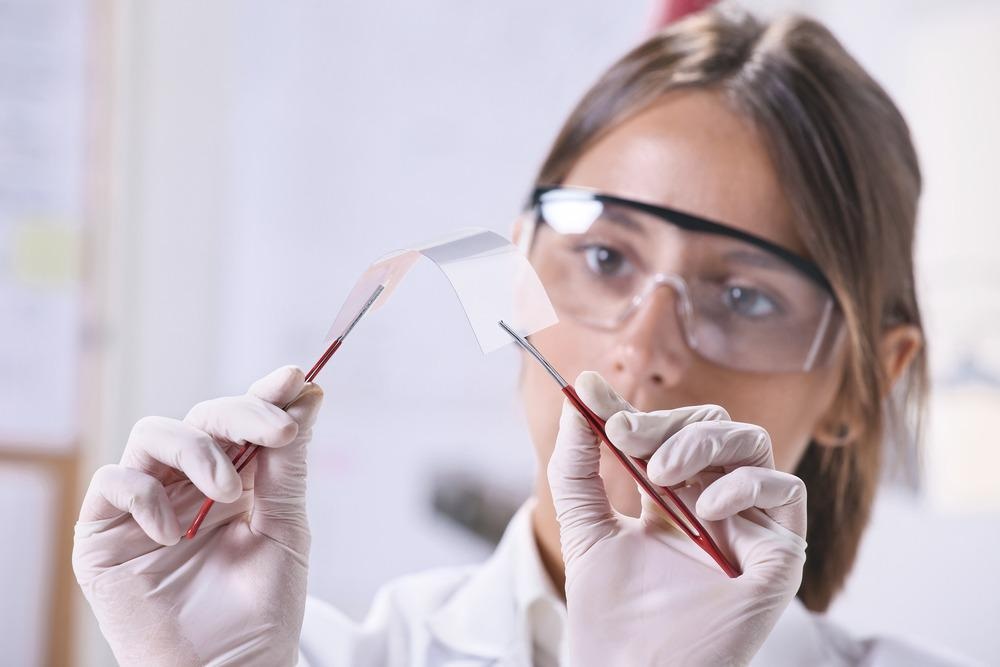A recent study published in the journal Materials Chemistry and Physics has found that graphene can increase the quality of metallic glass. Metallic glass needs to have high plasticity, and it can be achieved by layering with graphene nanocomposites.

Study: Effect of graphene on the mechanical properties of metallic glasses: Insight from molecular dynamics simulation. Image Credit: BONNINSTUDIO/Shutterstock.com
Metallic Glasses are Attractive Elements
Metallic glasses (MGs) are predicted to be attractive candidates for many technical fields, including aerospace-vehicle, biomedicine, electricals, and most manufacturing areas, due to their magnificent mechanical and physical effectiveness.
However, due to its poor tensile plasticity, MG engineering applications have indeed been severely hampered to date. This issue stems primarily from the fact that rapid transmission of shear bands (SBs) is created at ambient temperature by locating shear transformation zones (STZs).
Previous Efforts to Improve MGs Plasticity
As a result, enormous efforts have been made to improve the plasticity of MGs. The traditional method for improving its plasticity is to prevent the formation of regionalized SB and start producing uniform plastic deformation. To prevent the presence of single SB in MG, one technique is to decrease the MG's outer size to 100 nm, while another is to create the MG's heterogeneity by using a second phase.
Graphene, an Excellent Nanocomposite Materials
Graphene has been developed as an excellent material with exceptional strength and modulus of elasticity, and graphene-reinforced metallic composite materials have grown in popularity over the years. The impending graphene has the potential to strengthen and stiffen the metallic framework.
However, the process of collecting graphene into a cluster rather than retaining its 2D morphology decreases the quality of synthesized graphene.
Nanolayered Graphene with Metallic Glasses
The physical behavior of nanolayered graphene/Cu composite materials under uniaxial was systematically investigated, and the findings confirmed that graphene material and chirality have a massive impact on the composites' Young's tensile strength and modulus.
In comparison to commercial purified Al, the graphene-Al nanomaterials have higher tensile strength and hardness. Initial studies revealed that incorporating graphene can significantly affect the mechanical properties of metal materials.
Until now, research on the strengthening and hardening mechanism of graphene for metals has primarily focused on crystalline materials, but study on the impact of graphene on the mechanical characteristics of MGs is still lacking.
Research Process
First, the influences of graphene, as well as its engrained position upon mechanical characteristics of MGGNLs, were studied.
The tensile stress vs. strain curve is commonly used to categorize the mechanical characteristics of metal under external factor, such as tensile elastic modulus, yield strength, and plasticity, among other things. The elastic curve of the MGGNL is considerably greater than those of the bulk MG, and all contours in the elastoplastic regime boost linearly as even the strain tend to increase.
Results of the Research
Because of the high bond power among graphene's carbon molecules, the addition of graphene greatly increases the Elastic modulus of the bulk MG. In other utterances, incorporating graphene in the proper position of the MG will greatly enhance the MG's plastic deformation ability.
When conducting von Mises strain layering, it is worth mentioning that graphene and the MG phase have distinct coefficient ranges. Graphene is a high-strength substance that is resistant to large plastic deformation.
The findings further show that the graphene embedding position influences the mechanical characteristics and bending behaviors of MG/graphene nanolaminates (MGGNLs).
Advantage of this Research
The plastic deformation mode of the MGGNL shifts from the interactions of several shear bands (SBs) to the previous uniform deformation and finally to a dominating SB propagation as the graphene implantation distance increases. The findings show that adding graphene and adjusting its insertion position can provide high-strength and high-plasticity MGGNLs.
Limitation
The characteristics of the composite were dramatically improved when the graphene concentration was increased, and the plastic deformation process was also altered.
Plastic deformation is a solid material's capacity to undergo deformation or a non-reversible change in shape in reaction to external pressures.
The capacity of a substance to tolerate both plastic and elastic deformations is its toughness. The ability to endure shock and vibration is a highly desirable attribute for structural and machine parts.
Interview: Breakthrough for Atomic Arrangement of Amorphous Materials
Reference
Zhao, T., et al. (2022). Effect of graphene on the mechanical properties of metallic glasses: Insight from molecular dynamics simulation. Materials Chemistry and Physics. Available at: https://www.sciencedirect.com/science/article/pii/S0254058422000013?via%3Dihub
Disclaimer: The views expressed here are those of the author expressed in their private capacity and do not necessarily represent the views of AZoM.com Limited T/A AZoNetwork the owner and operator of this website. This disclaimer forms part of the Terms and conditions of use of this website.